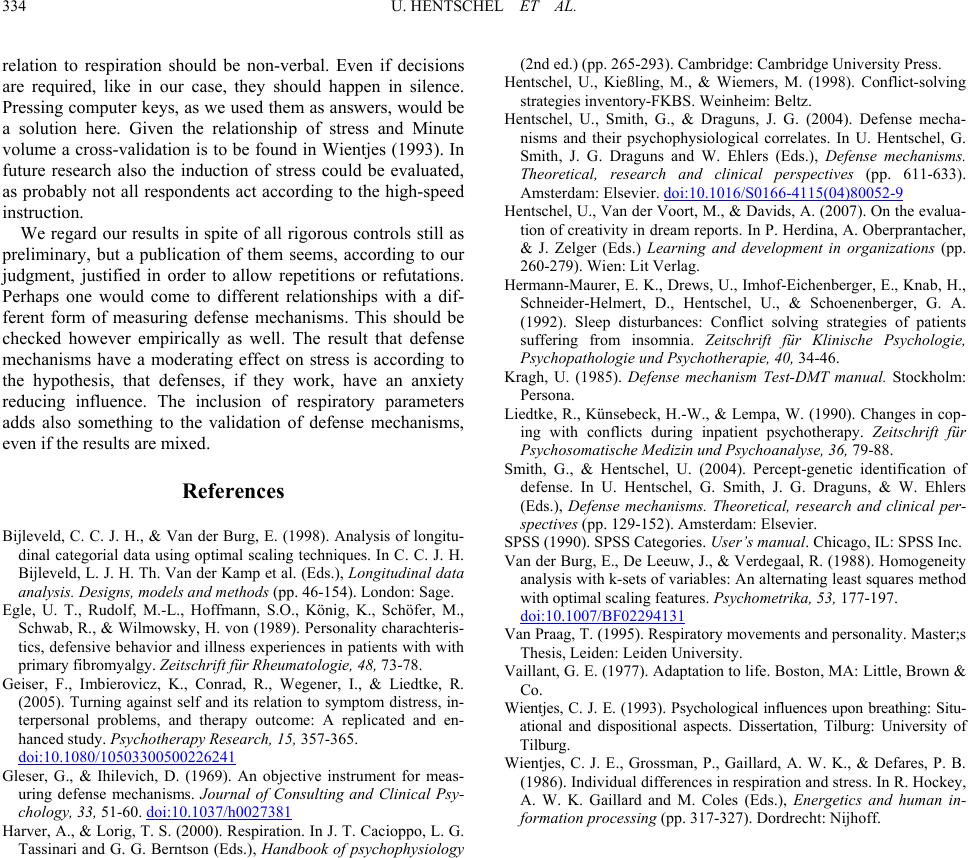
U. HENTSCHEL ET AL.
334
relation to respiration should be non-verbal. Even if decisions
are required, like in our case, they should happen in silence.
Pressing computer keys, as we used them as answers, would be
a solution here. Given the relationship of stress and Minute
volume a cross-validation is to be found in Wientjes (1993). In
future research also the induction of stress could be evaluated,
as probably not all respondents act according to the high-speed
instruction.
We regard our results in spite of all rigorous controls still as
preliminary, but a publication of them seems, according to our
judgment, justified in order to allow repetitions or refutations.
Perhaps one would come to different relationships with a dif-
ferent form of measuring defense mechanisms. This should be
checked however empirically as well. The result that defense
mechanisms have a moderating effect on stress is according to
the hypothesis, that defenses, if they work, have an anxiety
reducing influence. The inclusion of respiratory parameters
adds also something to the validation of defense mechanisms,
even if the results are mixed.
References
Bijleveld, C. C. J. H., & Van der Burg, E. (1998). Analysis of longitu-
dinal categorial data using optimal scaling techniques. In C. C. J. H.
Bijleveld, L. J. H. Th. Van der Kamp et al. (Eds.), Longitudinal data
analysis. Designs, models and m e th ods (pp. 46-154). London: Sage.
Egle, U. T., Rudolf, M.-L., Hoffmann, S.O., König, K., Schöfer, M.,
Schwab, R., & Wilmowsky, H. von (1989). Personality charachteris-
tics, defensive behavior and illness experiences in patients with with
primary fibromyalgy. Zeitschrift für Rheumatologie, 48, 73-78.
Geiser, F., Imbierovicz, K., Conrad, R., Wegener, I., & Liedtke, R.
(2005). Turning against self and its relation to symptom distress, in-
terpersonal problems, and therapy outcome: A replicated and en-
hanced study. Psychotherapy Research, 15, 357-365.
doi:10.1080/10503300500226241
Gleser, G., & Ihilevich, D. (1969). An objective instrument for meas-
uring defense mechanisms. Journal of Consulting and Clinical Psy-
chology, 33, 51-60. doi:10.1037/h0027381
Harver, A., & Lorig, T. S. (2000). Respiration. In J. T. Cacioppo, L. G.
Tassinari and G. G. Berntson (Eds.), Handbook of psychophysiology
(2nd ed.) (pp. 265-293). Cambridge: Cambridge University Press.
Hentschel, U., Kießling, M., & Wiemers, M. (1998). Conflict-solving
strategies inventory-FKBS. Weinheim: Beltz.
Hentschel, U., Smith, G., & Draguns, J. G. (2004). Defense mecha-
nisms and their psychophysiological correlates. In U. Hentschel, G.
Smith, J. G. Draguns and W. Ehlers (Eds.), Defense mechanisms.
Theoretical, research and clinical perspectives (pp. 611-633).
Amsterdam: Elsevier. doi:10.1016/S0166-4115(04)80052-9
Hentschel, U., Van der Voort, M., & Davids, A. (2007). On the evalua-
tion of creativity in dream reports. In P. Herdina, A. Oberprantacher,
& J. Zelger (Eds.) Learning and development in organizations (pp.
260-279). Wien: Lit Verlag.
Hermann-Maurer, E. K., Drews, U., Imhof-Eichenberger, E., Knab, H.,
Schneider-Helmert, D., Hentschel, U., & Schoenenberger, G. A.
(1992). Sleep disturbances: Conflict solving strategies of patients
suffering from insomnia. Zeitschrift für Klinische Psychologie,
Psychopathologie und Psychoth erapie, 40, 34-46.
Kragh, U. (1985). Defense mechanism Test-DMT manual. Stockholm:
Persona.
Liedtke, R., Künsebeck, H.-W., & Lempa, W. (1990). Changes in cop-
ing with conflicts during inpatient psychotherapy. Zeitschrift für
Psychosomatische Medizin und P s y ch o an a l ys e , 36, 79-88.
Smith, G., & Hentschel, U. (2004). Percept-genetic identification of
defense. In U. Hentschel, G. Smith, J. G. Draguns, & W. Ehlers
(Eds.), Defense mechanisms. Theoretical, research and clinical per-
spectives (pp. 129-152). Amsterdam: Elsevier.
SPSS (1990). SPSS Categories. User’s manual. Chicago, IL: SPSS Inc.
Van der Burg, E., De Leeuw, J., & Verdegaal, R. (1988). Homogeneity
analysis with k-sets of variables: An alternating least squares method
with optimal scaling features. Psychometrika, 53, 177-197.
doi:10.1007/BF02294131
Van Praag, T. (1995). Respiratory movements and personality. Master;s
Thesis, Leiden: Leiden University.
Vaillant, G. E. (1977). Adaptation to life. Boston, MA: Little, Brown &
Co.
Wientjes, C. J. E. (1993). Psychological influences upon breathing: Situ-
ational and dispositional aspects. Dissertation, Tilburg: University of
Tilburg.
Wientjes, C. J. E., Grossman, P., Gaillard, A. W. K., & Defares, P. B.
(1986). Individual differences in respiration and stress. In R. Hockey,
A. W. K. Gaillard and M. Coles (Eds.), Energetics and human in-
formation processing (pp. 317-327). Dordrecht: Nijhoff.